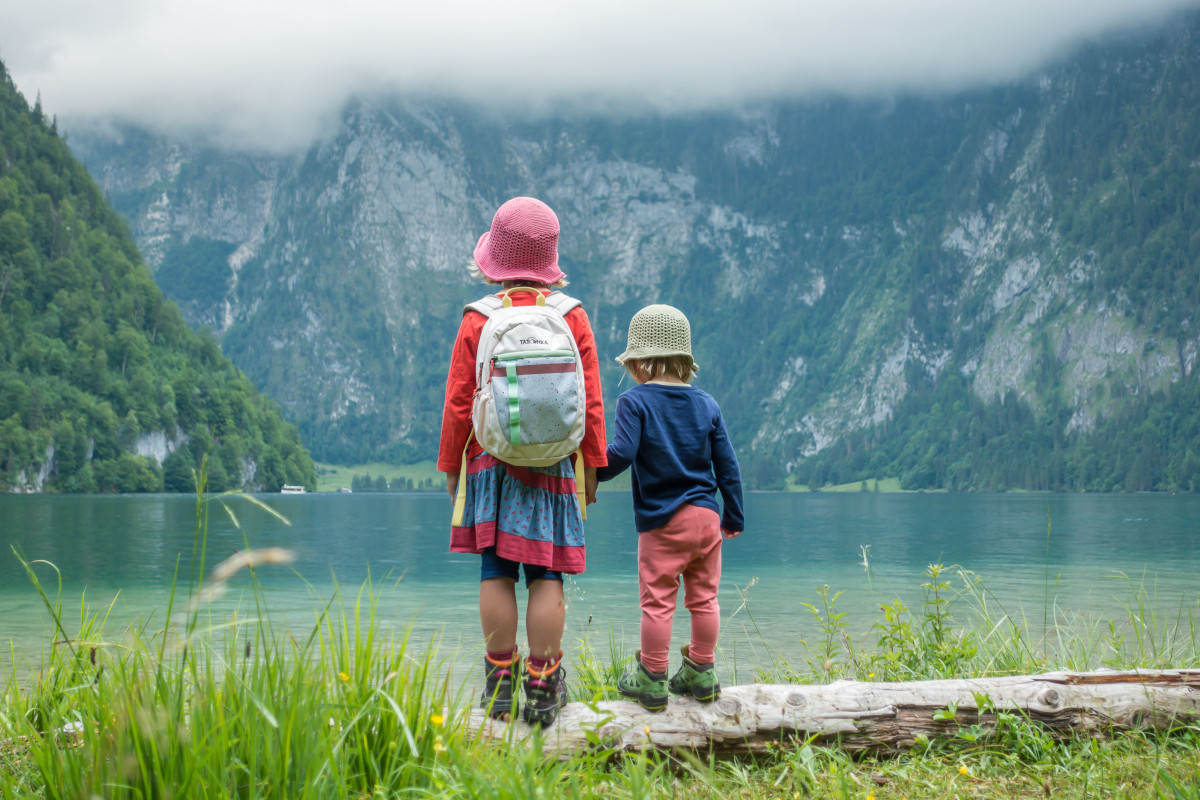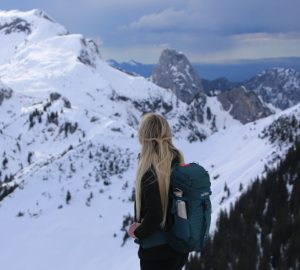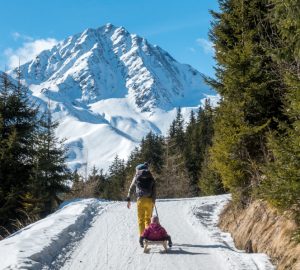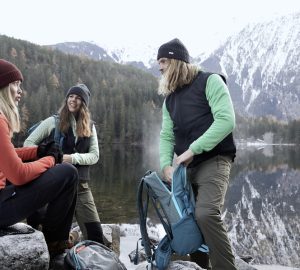For me, hiking with kids means spending undisturbed time with my family in nature. Doing an activity that I love myself: hiking. Today, this is called “quality time”. However, we – or rather my children – don’t just bounce up the mountain singing happily all the time. Anyone who hikes with children knows that such a hiking day can be exhausting for us parents. Boring trails, the wrong clothes, not enough snacks and not enough ideas in the hiking motivation trick box and already the hiking dream for the whole family becomes a frustrating day on the mountain.
In the following I have written down the 10 most frequently asked questions about hiking with kids for you. This will help you start your mountain adventure well prepared.
1. Is it possible for parents to hike with baby and toddler?
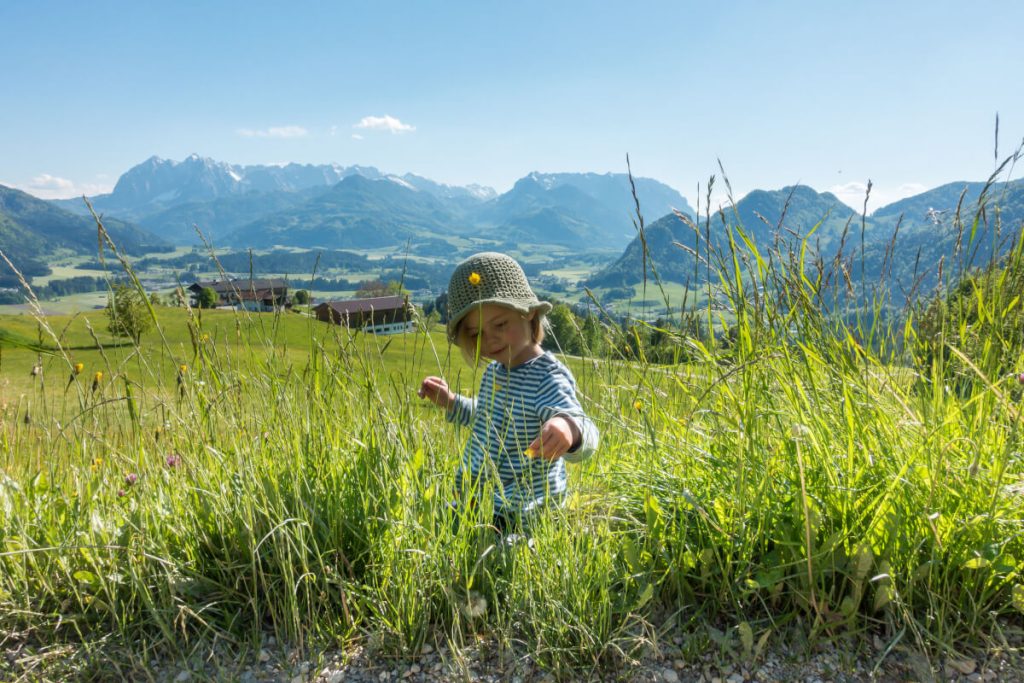
We have been hiking with our kids since they were babies. At first, they were allowed to observe the mountains from the carrier. Later, the child carrier (also called a Kraxe) gave them a brilliant all-round view.
My tip: Babies should only be carried in a child carrier (Kraxe) when they can sit independently and hold their head steady.
If we parents can still carry the children, then hiking is quite easy, because the tours don’t have to be suitable for children throughout. Not to mention the challenges that a toddler in the autonomy phase puts on the (mountain) day.
My tip: Let toddlers “hike” along the way again and again. It may well happen that you don’t make 20 meters of progress in half an hour or that you walk in the wrong direction. Discovering nature is important for children and lays the foundation for a later love of nature and the mountains. You can make distance when they want to be carried again.
2. At what age can children hike by themselves?
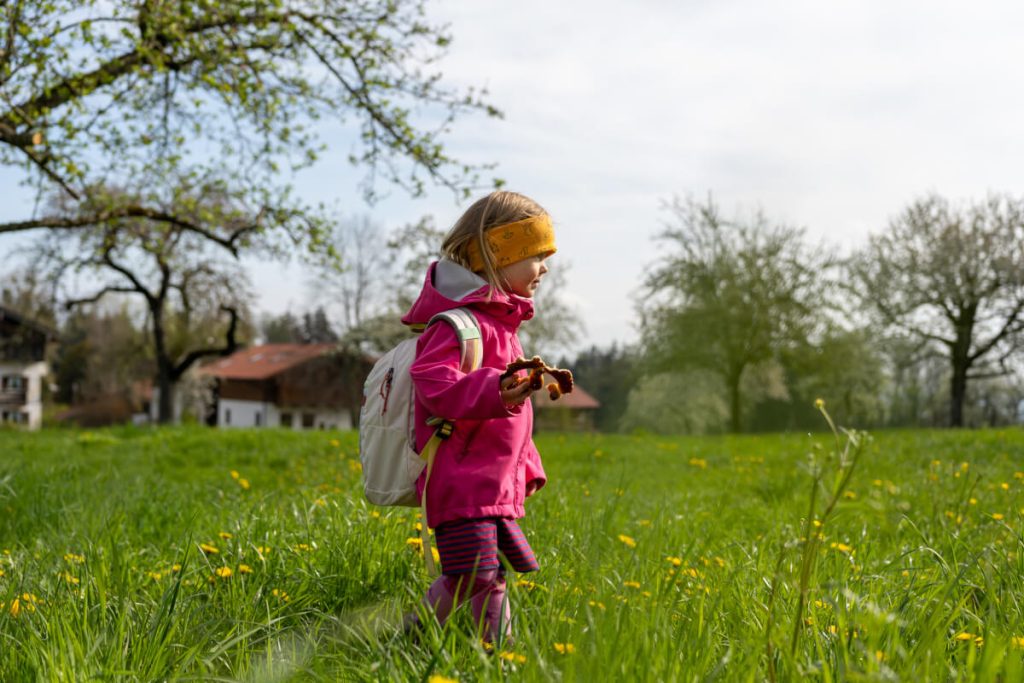
Hiking with kids becomes really exciting for us parents when they become too heavy to carry. This is often the case at around 3.5 years of age. My experience is that children can hike by themselves from this age. We parents then sometimes have to dig deep into the motivation box, bring along a lot of time and patience and put our sporting ambitions for hiking on the back burner for a while.
My tip: Pack a carrier in your backpack in case nothing goes forward or backward on the mountain, but you are pressed for time. There are carriers that are designed for a weight of up to 30 kg.
3. How far can children walk by themselves?
How far kids can hike themselves at a certain age is one of the most common questions I get as a family hiking blogger. However, I have a hard time with the answer. Because sometimes, even going to the bathroom seems like an unreasonable distance for the 3-year-old daughter.
My tip: Plan a lot of time for hiking with kids.
There is actually a formula for the distance a child can hike: Age of child * 1.5 = maximum trail length. 100 meters of altitude is counted as one kilometer. However, besides age, there are more unknown variables, such as the adventure level of the hiking trail or the factor of the child’s mood of the day, which cannot be represented in this formula. Nevertheless, this approach can serve as a guide for us parents. However, we have to approach the actual feasible trail length for our children ourselves. And we have to do this anew on every tour.
My tip: Don’t compare your children with other children, because every child is different, even when hiking.
4. Which tours are ideal for hiking with kids?
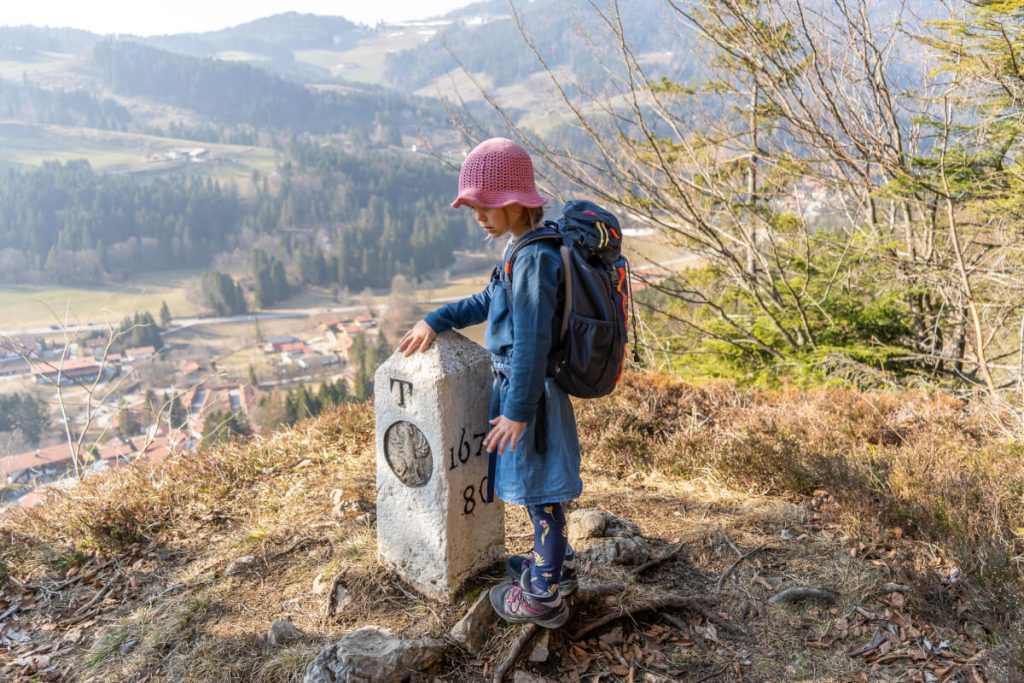
For children, the journey is the goal when hiking, and it has to be exciting. A successful hiking day stands and falls with the choice of the right hiking trail. For us parents, the choice of tour always means weighing up safety and adventure on the mountain. The trails must not be too difficult, i.e. too dangerous, especially for novice hikers. Easy hiking trails, however, are characterized by the fact that they are endlessly boring for children.
Paths over tree roots, along streams or even easy climbs promise variety. Wide forest paths or farm tracks, on the other hand, are unsuitable for hiking with children.
My tip: You should clearly invest a little more time in choosing the right tour. Blogs or hiking guides specifically for hiking with children are now available for many regions. With route planner apps, you can also flexibly adapt the suggested tours to the length of the children’s hiking legs or mood.
Stefanie explains tips on how to plan a hike for kids in detail in a separate post.
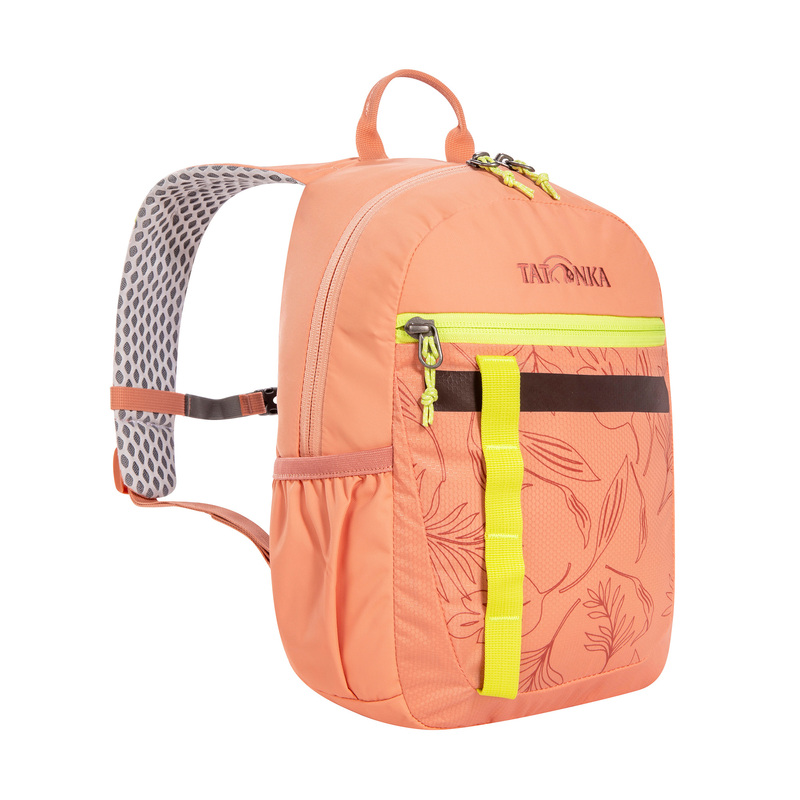
Whether for kindergarten, preschool, day trips or adventurous hut tours: at Tatonka you and your child are sure to find the right children’s backpack.
In different sizes and designs and with many practical features.
5. How many breaks do children need when hiking?
The best thing about hiking with children are the breaks we take together. How many breaks make sense is very individual and also depends on how much hiking trail is still ahead.
Breaks should be attractive for children. A hut stop as a break destination is always a good idea. The prospect of a cool drink, a delicious soup or a sweet Kaiserschmarrn can be quite motivating. It doesn’t always have to be a hut, though. A lake, a stream or a shady spot in the woods are also good. Children can find wonderful things to do in nature. We parents may be able to encourage them to rest a little. But it is more likely that they will jump up after their snack and go exploring.
My tip: A summit is not necessarily suitable for an extended hiking break with children. Depending on the summit and the character of the children, there is a risk of falling here.
6. When does a child become able to carry his or her own backpack?
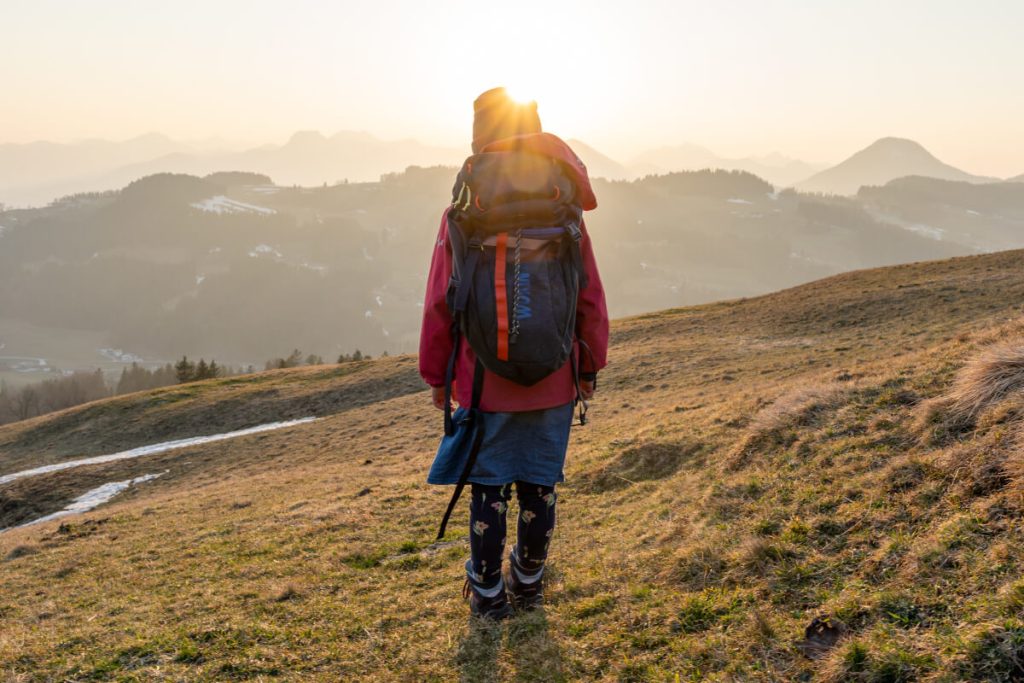
Children love to take on or carry responsibility. Whether or not a child wants to carry their own backpack is something I think they should be allowed to decide for themselves. Some children love to shoulder their drink, some snacks or even a pair of binoculars. Other children, on the other hand, feel constricted by the backpack.
My tip: Since hiking should simply be fun for the kids, don’t force a backpack on them if they don’t want it.
Basically, when hiking with kids: The size and weight of the backpack depend on the child’s size and physical condition. Kindergarten children should carry a maximum of 10% of their own body weight over a longer period of time and elementary school children a maximum of 3 kilos. Only from the age of about 9 years children can be a real help to you when carrying the hiking equipment.
7. Packing list for a day hike: What do parents need to pack for a hike with kids?

Packing for a day hike with kids isn’t that hard. However, our backpack will be very heavy. Because depending on the weather and the age of the kids, diapers, a change of clothes and provisions add up. A sufficiently large backpack that can hold the hiking luggage of an entire family and is comfortable for the person carrying it is a worthwhile purchase for us parents.
Here is my personal packing list for a day hike with kids:
- Drinks: about 1 liter per person.
- Food: e.g. cheese sandwiches, sliced apples, grapes, carrots, nuts, granola bars and of course some sweets. It’s amazing how a gummy bear can help you get over a motivation low.
- Another layer of clothing: it’s usually colder on the mountain than in the valley
- Depending on the weather: muddy pants for the kids
- A change of clothes: a pair of socks, a change of pants and a change of T-shirt for each child.
- Rain jackets (depending on the weather)
- For the hiking motivation of the children: e.g. a pocket knife, a forest bingo, a cup magnifying glass
- Small first aid kit
- Sunscreen & insect spray
- Handkerchiefs
- A garbage bag
- Smartphone
- Wallet
- Camera
My tip: Prepare the things you want to take with you the night before. So you avoid hectic on the morning of the hike and do not forget anything important.
8. How can parents motivate children to hike?
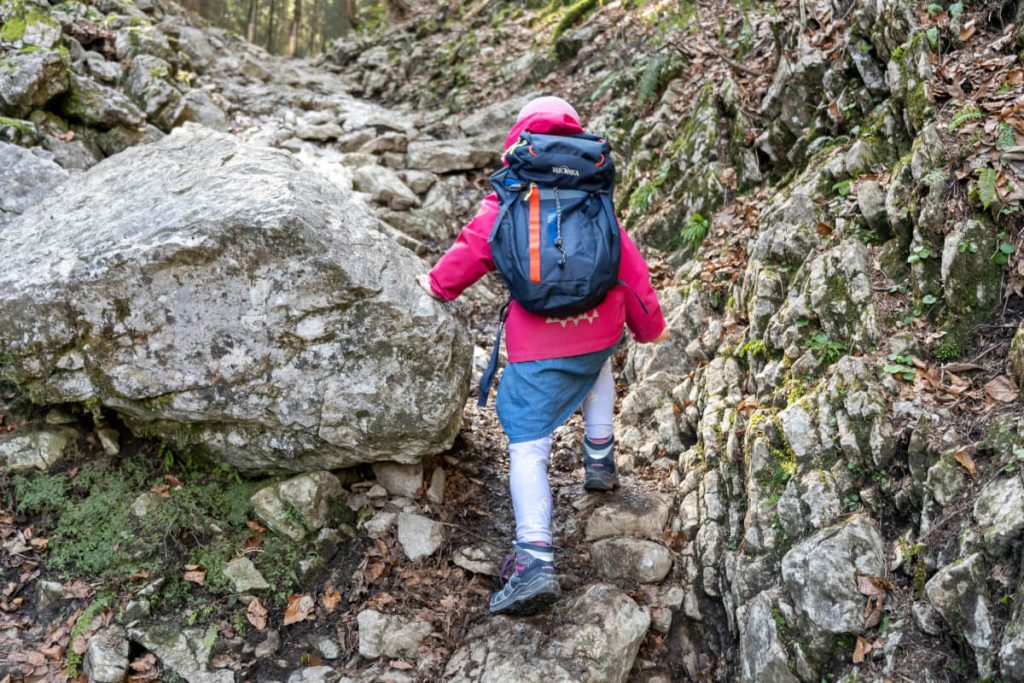
Exciting hiking trails are the key to motivating children to go hiking. With an adventurous trail, they forget that they are hiking at all. However, I have not yet come across a tour that offers interesting trails without exception. In such a case, we parents have to reach into the motivational bag of tricks. For children, “I can’t walk anymore” very often means “I’m bored.
My tip: Take your children’s needs seriously when they are walking (and, of course, at all other times). If they don’t want to walk anymore, make sure they’re not hungry or thirsty, they’re not too cold or too hot, and they really don’t need a break, instead boredom is speaking out of them.
To bridge a motivation low, distraction clearly helps. Nature offers many opportunities for this: Look for logs to balance on or practice whistling on blades of grass. Collect walking sticks, which can then be anything from a rocket to a unicorn, depending on your child’s imagination. Collect nature treasures or play hide and seek. The older the kids get, the easier it is to play guessing games with them or engage them in conversation.
The best motivation can be hiking with friends. But even this can sometimes backfire: Because kids can also really demotivate each other.
How to motivate your kids to hike, Stefanie explains in more detail in a separate post.
9. What equipment do children need when hiking?
Little hikers need good equipment. This includes suitable footwear and functional clothing. A child’s hiking shoe should fit well and in no case be too small, because if the shoe pinches, no child will hike anywhere. It should also be waterproof and have a high shaft that protects children from twisting their ankles.
We parents should pay attention to functional clothing when hiking with kids, which can be combined according to the onion principle. This way, one layer can always be put on or taken off when needed. Since children often only wear their clothes for one season, there is a large selection of good condition outdoor clothing to buy used.
My tip: Getting dirty must be allowed. You nip any hiking fun and basically any outdoor adventure in the bud with the phrase: “Don’t get dirty”.
10. Are parents able to go on a hut hike with children?
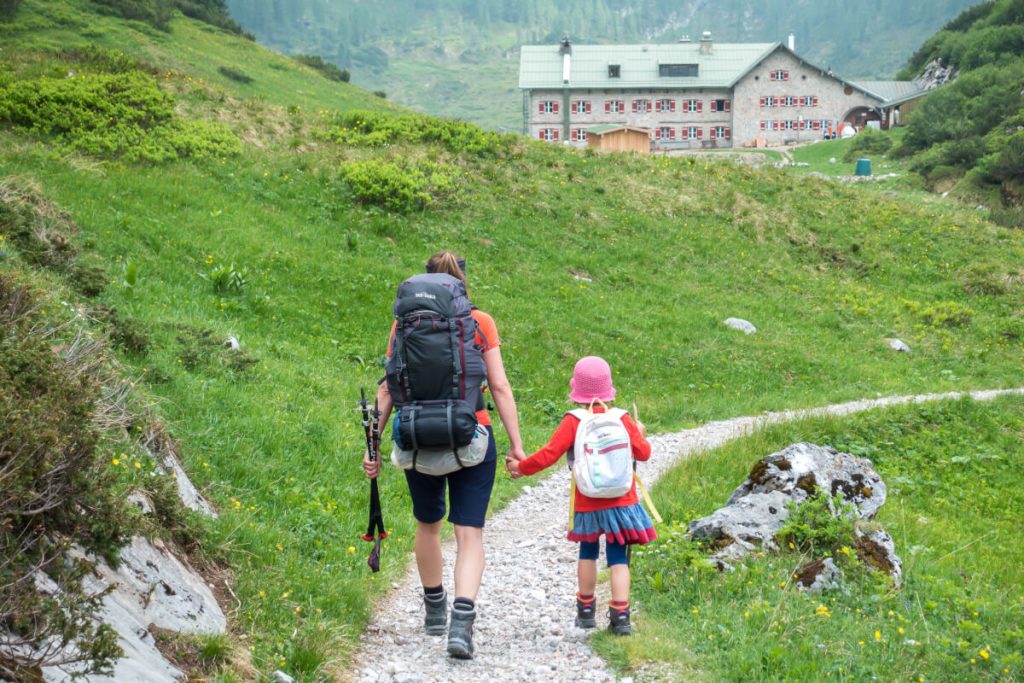
We parents don’t have to give up an overnight stay in a hut when hiking with kids. Even with the smallest hikers we can spend a night at a hut. An intense family time incl. adventure feeling are guaranteed.
Start with one night to first approach the topic, choose a hut that you can easily reach and that offers room location. A reservation is obligatory, but rigid bedtime rules for the children on such an exciting day are not.
My tip: Here you can read my 10 tips for a hut tour with children
Have fun hiking with your kids. And because I’m often asked about the absolute must-have for hiking with kids: As parents, have fun and be enthusiastic!




